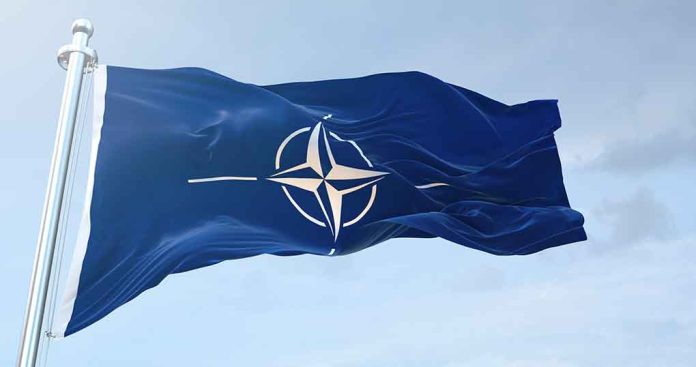
Russia’s grinding war machine continues to advance in Ukraine despite staggering casualties that have already exceeded 1 million, as NATO officials warn of a “stressful and difficult summer” ahead with little hope for diplomatic resolution.
Key Takeaways
- Russia is suffering approximately 1,300 casualties daily but continues making slow territorial gains in Ukraine, with NATO predicting the conflict will extend for years.
- Despite economic strain and depleting its sovereign wealth fund from $150 billion to $37 billion, Russia can finance the war until at least 2027 while maintaining strong weapons production.
- NATO officials warn Russia may pose a direct threat to Alliance members within five years, with concerns that Russia’s military spending now exceeds that of all 27 EU nations combined.
- Russia has seized less than 1% of Ukrainian territory since January 2024 but is making steady advances in Sumy and intensifying operations in Zaporizhzhia.
- Prospects for diplomatic solutions remain dim as the Trump administration shows limited interest in continued weapons support for Ukraine.
Russia’s War Machine: Brutal Advances at Devastating Cost
Russia continues to make slow but steady advances across the Ukrainian frontline despite suffering catastrophic losses that would cripple most modern armies. NATO intelligence indicates Russian forces are taking approximately 1,300 casualties daily in 2024, with total losses since the invasion began approaching a staggering one million dead and wounded soldiers. Despite these losses, Russian military production remains robust, with factories churning out 130 tanks and 3 million artillery shells annually, allowing Putin to maintain pressure along the 1,000-kilometer front line while intensifying operations in key sectors like Sumy and Zaporizhzhia.
“The real bottom line is that the situation on the battlefield continues to be difficult. Ukraine continues to show a lot of innovative spirit…but we’re in for a stressful and difficult summer,” according to a senior NATO official.
Russia’s battlefield performance, while steady, has been remarkably inefficient. Military analysts note that Russian forces have advanced at a glacial pace of only 50 meters per day in some areas, far slower than historical offensive operations. This sluggish progress comes at an enormous cost, with equipment losses outpacing Ukraine’s at ratios between 5:1 and 2:1. The poor performance stems from Russia’s reliance on infantry-heavy tactics, lack of coordinated operational fires, and Ukraine’s effective defensive preparations – yet Putin’s forces continue grinding forward through sheer attrition warfare.
Economic Strain vs. Military Priorities
Russia’s economy is showing significant strain from the prolonged conflict, with acute labor shortages and growing budget deficits threatening long-term stability. The Kremlin has dramatically depleted its sovereign wealth fund, which has plummeted from $150 billion to just $37 billion as Putin prioritizes war financing over domestic economic health. Despite these concerning indicators, NATO officials assess that Russia can continue financing the war effort until at least 2027, demonstrating Putin’s willingness to sacrifice Russia’s economic future for immediate military objectives in Ukraine.
“Industrial capacity is operating at a maximum, but you have labor shortages, significant budget deficits, which are being funded partly by the national welfare fund, but that is starting to run quite low. The sovereign wealth fund has fallen from $150 billion to $37 billion. So all this is certainly putting a strain on the Russian economy,” according to a senior NATO official.
This strategy reveals Moscow’s calculation that short-term military success outweighs long-term economic damage. Russia now spends more on defense than on healthcare, education, and social policy combined, according to EU foreign policy chief Kaja Kallas. This massive military investment supports Putin’s war in Ukraine while simultaneously preparing for potential future confrontations with NATO – a concerning pattern that suggests Russia’s aggressive posture extends beyond Ukraine’s borders to the broader European security architecture.
NATO’s Growing Concerns About Broader Russian Threats
NATO’s leadership has issued stark warnings that Russia’s ambitions likely extend beyond Ukraine, with alliance officials suggesting Putin could potentially attack a NATO member within the next five years. These concerns intensified following a Russian missile strike on a Kyiv apartment building that killed 28 civilians – the deadliest attack on Ukraine’s capital this year. The alliance has documented increased Russian sabotage and cyberattack activities across Europe, with some officials suggesting these operations could eventually test NATO’s Article 5 collective defense commitment.
“Russia is already a direct threat to the European Union….This is a long-term plan for long-term aggression. You don’t spend that much on military if you do not plan to use it,” said Kaja Kallas.
The Ukraine conflict has revealed significant weaknesses in Russia’s conventional military capabilities, with poor coordination, equipment losses, and personnel challenges hampering performance. However, NATO analysts note that Russia continues adapting its approach and rebuilding combat power despite these setbacks. With diplomatic solutions appearing increasingly remote and uncertainty surrounding continued Western military support under the Trump administration, Ukraine faces a challenging strategic position. Meanwhile, tensions between Israel and Iran add another layer of complexity, potentially disrupting Iran’s supply of ballistic missiles and artillery munitions to Russia’s war effort.













